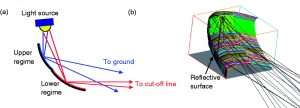Bike lights should make the bicycle visible to other road users without causing glare and also illuminate the ground. Standards such as the European K-mark require that the first two conditions are met but do not require a very high standard of ground illumination. In the K-mark standard illuminance is measured at a distance of 10m from the light. Directly in front of the light the illuminance should be greater than 20 lux, at an angle of 3.4 degrees higher the illuminance should be less than 2 lux and towards the ground it should be greater than 2 lux. This is not sufficient to illuminate the ground. Achieving all three requirements requires a light to have a carefully designed illuminance pattern, which has not been achieved by commercially available lights.
This study used ray tracing simulation to develop a light with the desired illuminance pattern and then validated the design experimentally. The novel design meets the requirements of the k-mark standard. It has an illuminance of 30 lux directly ahead and a clear cut-off so that the light at elevation angles of greater than 3.4 degrees is minimal and will not cause glare. The design also provides good illumination of the ground, with a maximum intensity of 9 lux and at least 3 lux up to 7 m from the light. It shows that the novel design provides safer illumination for a bicycle rider while only consuming 2.5 W of power.

Abstract:
A novel design of phosphor-converted, white light emitting diode-based bicycle head lamp producing sufficient illuminance on the target to meet the K-mark regulations and additional illumination on the ground is proposed and demonstrated. The phosphor-converted, white light emitting diode has a power demand of 2.5 W, while the novel design offers a maximum illuminance of 30 lux at the HV point, and illuminances larger than 3 lux across the first 7 m on the ground. The optical utilisation factor for the target illumination is 30% and for the ground is 44%. It means that around 74% of the luminous flux emitted by the phosphor-converted, white, light emitting diodes is utilised. This novel and highly efficient bicycle head lamp provides safer illumination for bicycle riders.
Reference:
“Design of a highly efficient LED-based bicycle head lamp with additional ground illumination”
J-Y Cai Y-C Lo S-T Feng C-C Sun
Lighting research & technology. , 2014, Vol.46(6), p.747-753
Let us know what you think